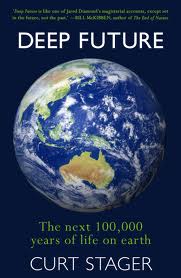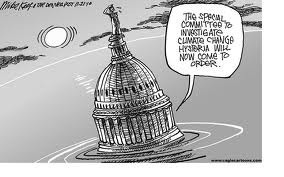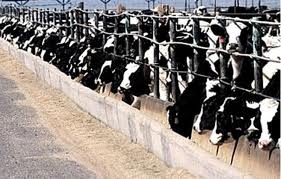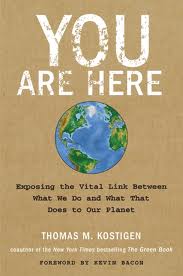Last week, I visited the excellent Sydney Writers’ Festival, showcasing an eclectic mix of novelists, journalists, poets and non-fiction writers in a stunning setting on and around the wharves in Walsh Bay. One of the big themes this year was that of climate change, and I attended two very interesting talks on the subject: Curt Stager’s Deep Future and Merchants of Doubt by Naomi Oreskes.
Deep Future: The next 100,000 years of life on earth.
Curt Stager is a paleoclimatologist who has studied the impact of climate change on the world in the past, and now brings his unique knowledge to imagine how the world will look after decades of man-made global warming. His book Deep Future: The Next 100,000 Years of Life on Earth looks at the impact of global warming based on past events.
Deep Future: Best Case
In this vision, Curt takes the best case where mankind has worked together to stop global emissions within the next thirty years. As there is a time lag between greenhouse gases being created and their build-up in the atmosphere, he forecasts that the worst effects will be felt at the end of this century. He believes that the overall temperature of the earth will increase by 2 to 3 degrees C and that global cooling will follow from 2200 onwards. It may take several thousand years for the ocean to soak up the CO2 and probably around 100,000 years to completely neutralise the effects of global warming. And this also means that the next expected Ice Age in about 100,000 years time will not happen.
Even this seemingly small temperature change leads to significant changes in the world’s climate zones. Most of Africa will become a desert and people will migrate to the cooler countries to the north. This happened before in the Interglacial period when the first humans migrated from Africa to Europe, as proven by archeological findings from that period. Sea levels will also rise and many coastal cities will need to be relocated further inland. This may bring unexpected benefits to inland cities which then become harbours; in the past, rising sea levels created the harbour in Amsterdam, allowing it to become a successful sea port and naval power. In Australia, Perth is likely to be under the sea whilst South Australia will become even drier and hotter. The weather will become more extreme as the moisture in the atmosphere increases, leading to wetter weather in the tropics and monsoonal areas.
Deep Future: Worst Case
Curt then imagined how the world will look if we continue to burn fossil fuels until they run out. He envisages a global temperature rise of 10 degrees C with 2000 parts per million of CO2 in the atmosphere, at five times the current level of 400ppm. This temperature increase will last thousands of years and the global cooling back to the average could take a million years! He pointed out that there was a similar but unexplained increase in CO2 emissions around 55 millions years ago which led to a 70 metre rise in sea levels. As you can imagine, this would wipe out not just coastal cities but many low-lying islands and even whole countries such as Holland, Belgium and even most of the UK.
He also told of a very tragic event in Cameroon in 1986, where a natural explosion of carbon dioxide gas from Lake Nyos killed all living creatures within a radius of 25km, with 1700 people losing their lives. Other lakes in Africa are reporting similar build-ups of CO2 and this phenomenon remains a plausible threat in the future.
Curt also highlighted the potential for conflict between countries, as climate change leads to a changing landscape. For instance, as the Arctic ice melts new shipping lanes are being created and there is already a dispute between Canada, Russia and Greenland as to the ownership of these newly created routes. As the Antarctic begins to thaw, the current agreements between nations are likely to be under threat as mining and development becomes economically viable.
Curt Stager certainly presents a fascinating insight into the changes that we can expect from global warming, and it was particularly alarming that these effects may last thousands of years.
Don’t forget to check Food’s Carbon Footprint for ideas on how you can make a difference by reducing your carbon footprint right now!
Merchants of Doubt
Naomi Oreskes also looked to the past to explain current and future events, but her historical research was rather more recent. Her book Merchants of Doubt: How a Handful of Scientists Obscured the Truth on Issues from Tobacco Smoke to Global Warming looks at how lobbyists, think tanks, scientists and industry use ‘doubt-mongering’ to deny facts that are not to their immediate benefit. Although climate change is their current target, past issues such as smoking and cancer, air pollution and acid rain, CFCs and the ozone hole have all been subject to their campaigns of disinformation.
These Merchants of Doubt have significant access to high-level politicians and often hold positions of power themselves. Some of the same people crop up again and again with their policy of denial, which serves to maintain the status quo and keep the industry giants happy. Many of them are scientists with good credentials that appear to be carried away with their own self-importance and are now unable to reach an informed opinion.
Why Do We Believe Them?
The doubt-mongerers often are high-profile individuals with powerful friends that allow them access to the media, backed by a very well-funded network of institutes, think tanks and industrial lobbyists. They also employ professional marketing and advertising agencies, that are able to present the case in the most persuasive manner. The opposing scientific community does not have similar backing and finds it distasteful to engage in debate when they know their opponents are often resorting to lies and deception. Naomi also believes that there comes a tipping point, when the public eventually sees through the deception, and no longer gives credence to the denialists. This happened in the late 1970s with smoking and lung cancer, when juries began to award damages to smokers after years of denial by the tobacco industry.
Climate Change Deniers
Naomi described some of her personal experiences with the current crop of climate change deniers. She said that there are thousands of papers proving that climate change is happening and that it is caused by greenhouse gas emissions, whilst there are only a few that refute this evidence. One denier continues to quote the cloud protection theory, that theorised that increases in cloud cover would neutralise global warming, even though this has been completely refuted by all the evidence. She gave evidence on climate change in the US Congress and had to oppose a scientist who was telling outright lies.
What of The Future?
Naomi stated that ‘the evidence is strong enough to say that life is being threatened right now by climate change’. She talked of the heatwave in Europe that killed 40,000 people and the flooding and forest fires that are occurring across the globe. There is already a huge cost to infrastructure and anxiety and fear is increasing world-wide.
She believes that there is still a stalemate on the climate change issue in the US, especially as people are resistant to changing their way of life and would rather see technological fixes. She thinks that there is a lack of political will to change and that it is time for ordinary people to makes their voices heard. And we can all start to make a difference by making lifestyle changes – look at Food’s Carbon Footprint for some ideas on how to start at home today.









Trackbacks/Pingbacks